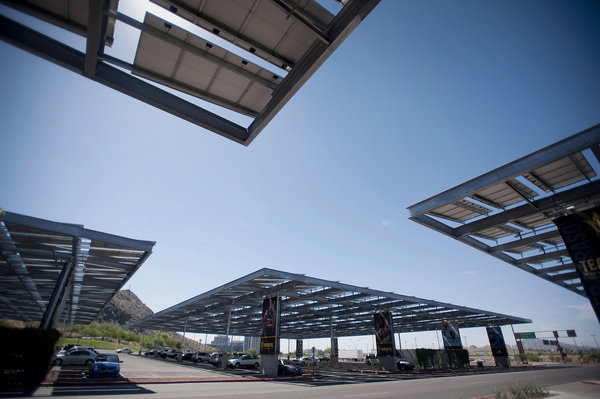forum
library
tutorial
contact

Utah Land Set Aside for Solar Power
by Ladd EganKUTV, July 9, 2013
|
the film forum library tutorial contact |

|
Utah Land Set Aside for Solar Powerby Ladd EganKUTV, July 9, 2013 |
President Obama goal is to green-light enough private renewable energy capacity
on public lands to power more than 6 million homes by 2020
 The U.S. Department of the Interior has restricted new mining claims on approximately 18,000 acres of Utah land as part of a plan to use public lands in Western states to generate solar power.
The U.S. Department of the Interior has restricted new mining claims on approximately 18,000 acres of Utah land as part of a plan to use public lands in Western states to generate solar power.
Nationwide, nearly 304,000 acres are included in the Public Land Order which withdraws the land from new mining claims for the next 20 years to facilitate the development of solar energy projects.
The land is part of 17 "Solar Energy Zones" established by the Interior Department in 2012 in Arizona, California, Colorado, Nevada, New Mexico and Utah as areas with high solar power-generating potential and minimal potential for environmental damage due to the construction of solar farms.
"The Public Land Order protects the integrity of the Solar Energy Zones and helps us meet President Obama's goal of green-lighting enough private renewable energy capacity on public lands to power more than 6 million homes by 2020," said Bureau of Land Management Principal Deputy Director Neil Kornze in a press release.
Utah's three Solar Energy Zones are each about 6,000 acres in size and are located in the Wah Wah Valley and Milford Flats South areas, both in Beaver County and the Escalante Valley in Iron County.
"We have a lot of solar resources here in Utah because we have so many rain-free days and really good sun," said Rene Fleming with St. George's power department.
While Utah is ideal for solar power generation, Fleming says there are obstacles to getting companies to build solar farms.
"They're going to want to be able to make a profit for it," Fleming said. "One of the big problems with renewable energies is they are often in remote areas with no transmission."
Building transmission lines to the solar farms would be expensive not only because of construction costs but also due to the mandatory environmental studies and having to secure right-of-ways, Fleming explained.
Rocky Mountain Power says it supports efforts to build the solar farms and other renewable energy facilities and would work with companies to connect to the transmission system.
"While the BLM studies identified locations and acreage most suitable for solar energy development, they did not identify the size of the projects in terms of electrical output or when these projects might be developed," said Maria O'Mara, spokesperson for Rocky Mountain Power. "Without that information, it is difficult to assess transmission interconnection requirements."
O'Mara said the three areas set aside for solar power generation in Utah are located relatively close to transmission lines but that additional infrastructure would be required to get the power onto the grid.
The federal government says it will fast-track the approval of utility-grade solar farms in the designated areas and also offer economic incentives and other forms of assistance to companies who build the solar facilities.
The Interior Department projects that if solar farms are built on all 17 locations they will produce enough electricity to power approximately 1.8 million American homes.
learn more on topics covered in the film
see the video
read the script
learn the songs
discussion forum
